Kurt Vonnegut graphed the world’s most popular stories. Do his diagrams tell us something important about humanity?
The Slaughterhouse-Five author believed there were just eight different story 'shapes'—and that they might be of interest to anthropologists. The anthropologists thought otherwise. But why?
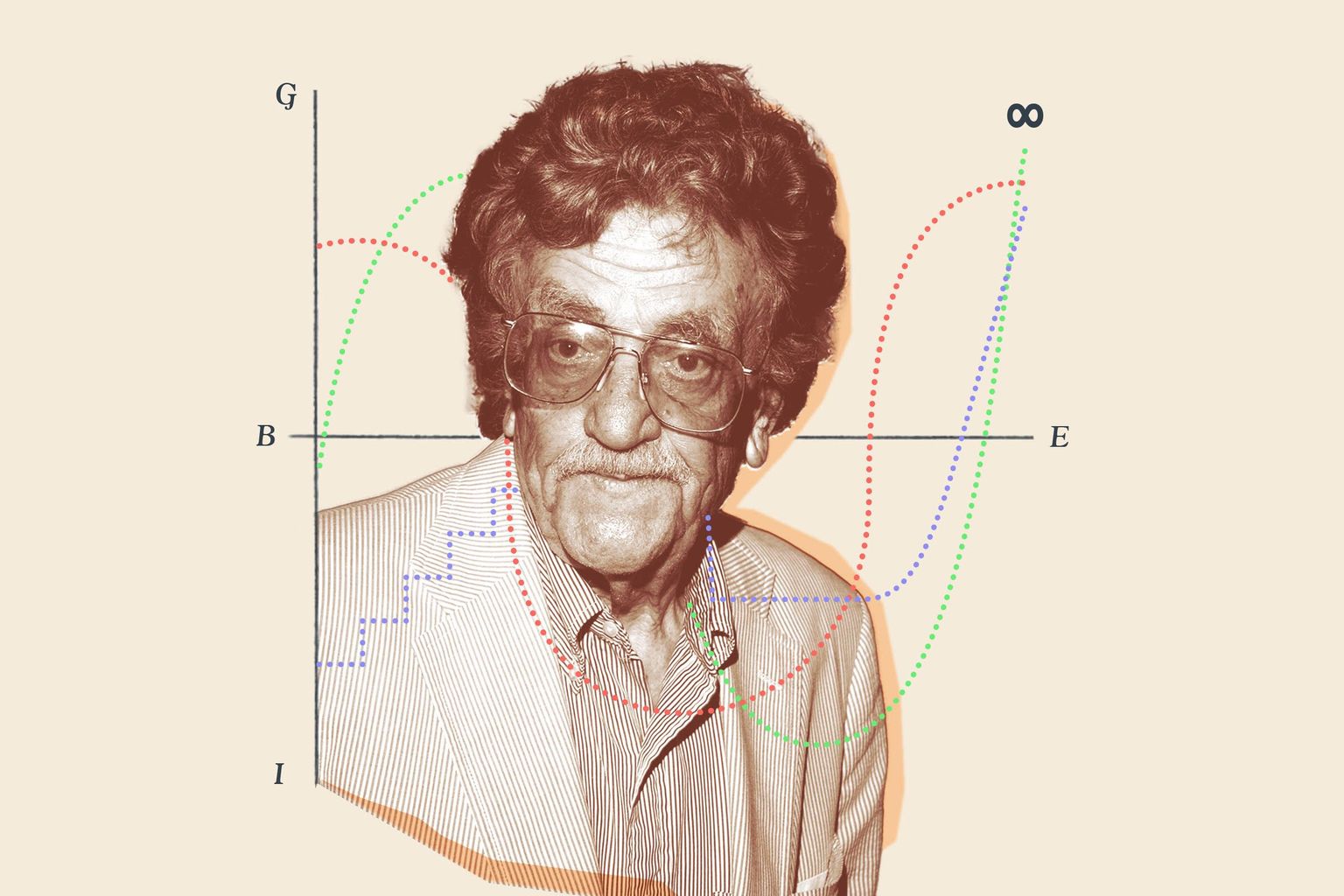
Photo illustration: Emily Thiang/Shutterstock. Graphs: Emily Thiang
You can tell a lot about a culture by the tales it tells. In the remnants of stories through history, whether on stone tablets or backed up Tumblr archives, you can find traces of the cultural forces that made them; encoded amongst the plot points and the dialogue are instructions for survival, for morality, for establishing power relations, for finding out where the good fish are and why it’s worth waiting for them.
That, at any rate, was how a young Kurt Vonnegut saw things back in the 1940s. Vonnegut, not yet one of the most successful authors of the 20th century, was studying anthropology at the University of Chicago when he got the idea to map the ups and downs of the novels he was reading in his downtime. The project started as a lark, but as he later remarked in his essay collection Palm Sunday, what he discovered on those graphs would amount to his “prettiest contribution to my culture”: a unified theory of narrative arcs.
“The fundamental idea,” he wrote, “is that stories have shapes which can be drawn on graph paper, and that the shape of a given society’s stories is at least as interesting as the shape of its pots or spearheads.” Intrigued, he submitted the theory to the anthropology department as a thesis proposal. His aim was to spend the next few years investigating whether different cultures told stories that followed different shapes. But the stuffy robes didn’t share in Vonnegut’s vision of stories as cultural artefacts. His thesis was rejected, he said, “because it was so simple and looked like too much fun. One must not be too playful”.
Dejected, Vonnegut ditched anthropology and went to work for GE, where, instead of reading in his downtime, he began writing the satirical novels for which he would one day become famous (Cat’s Cradle and Slaughterhouse-Five among them). But Vonnegut never abandoned his idea of story shapes entirely, and returned to it often over the following decades in the lectures he gave on creative writing. Fragments of these survive today on YouTube and, as a crash course in plotting a novel, a movie or even a campfire story, you’d be hard pressed to find better advice put more succinctly.
To graph a story, Vonnegut wrote in Palm Sunday, you simply have to crucify it. Draw yourself two axes, with X representing the story’s chronology from beginning (B) to end (E), and Y representing the protagonist’s fortune from good (G) to ill (I). Map the rise and fall of your character’s fortune over that B to E time scale and—hey presto—you have yourself a bonafide story shape.
Map enough stories, though, and you’ll notice something curious: the same shapes reappear over and over again. The most common Vonnegut dubbed “Man in a Hole”. It follows this trajectory: a character leading a perfectly bearable life finds misfortune, overcomes it, and is happier afterwards. “You see this story again and again,” Vonnegut said. “People love it, and it is not copyrighted.”
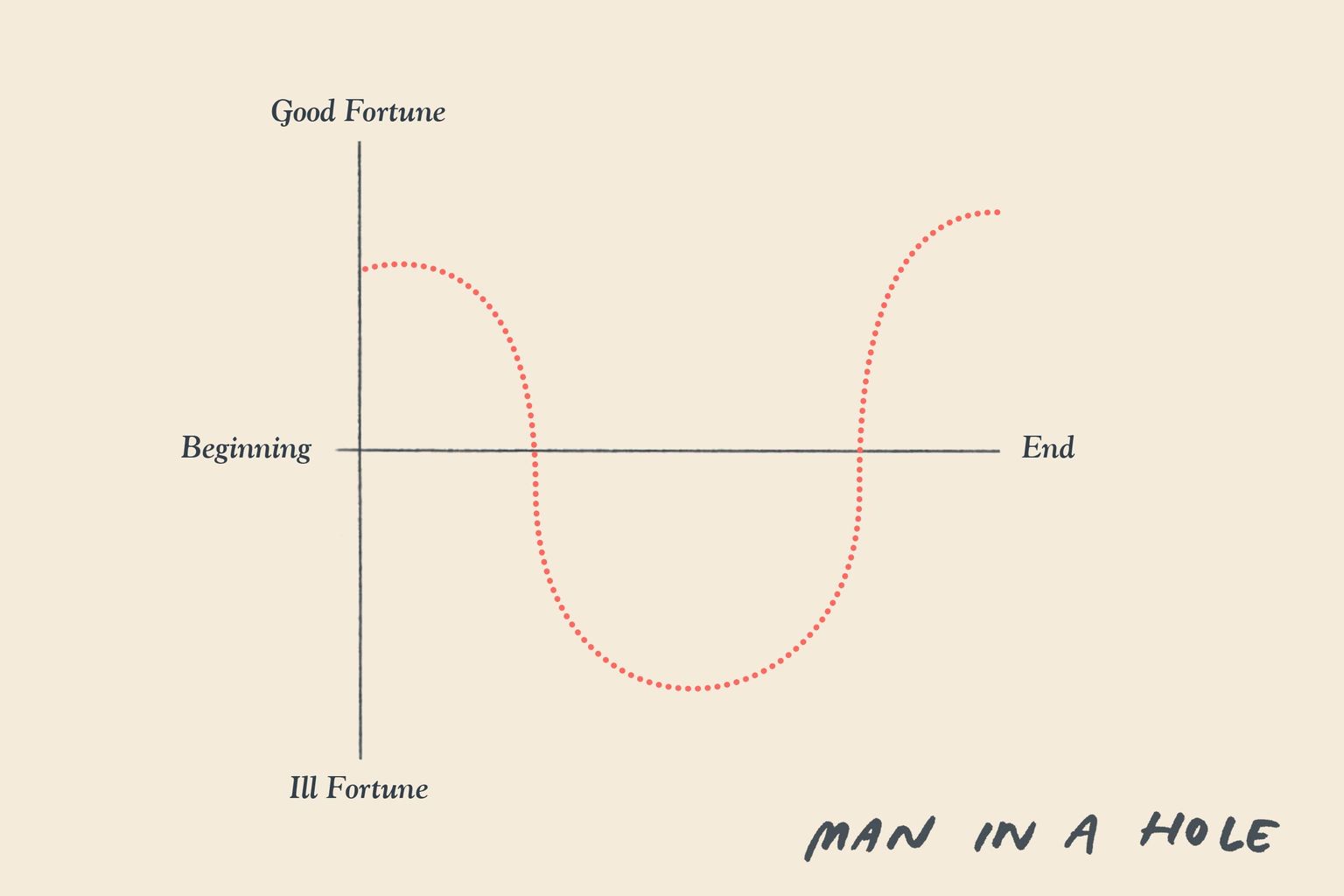
Not so dissimilar is “Boy Meets Girl”, also known as every romcom plot ever committed to celluloid: a person finds something they like, loses it, and gets it back. The protagonist’s relative happiness depends on their initial loss—as does our enjoyment of the story.
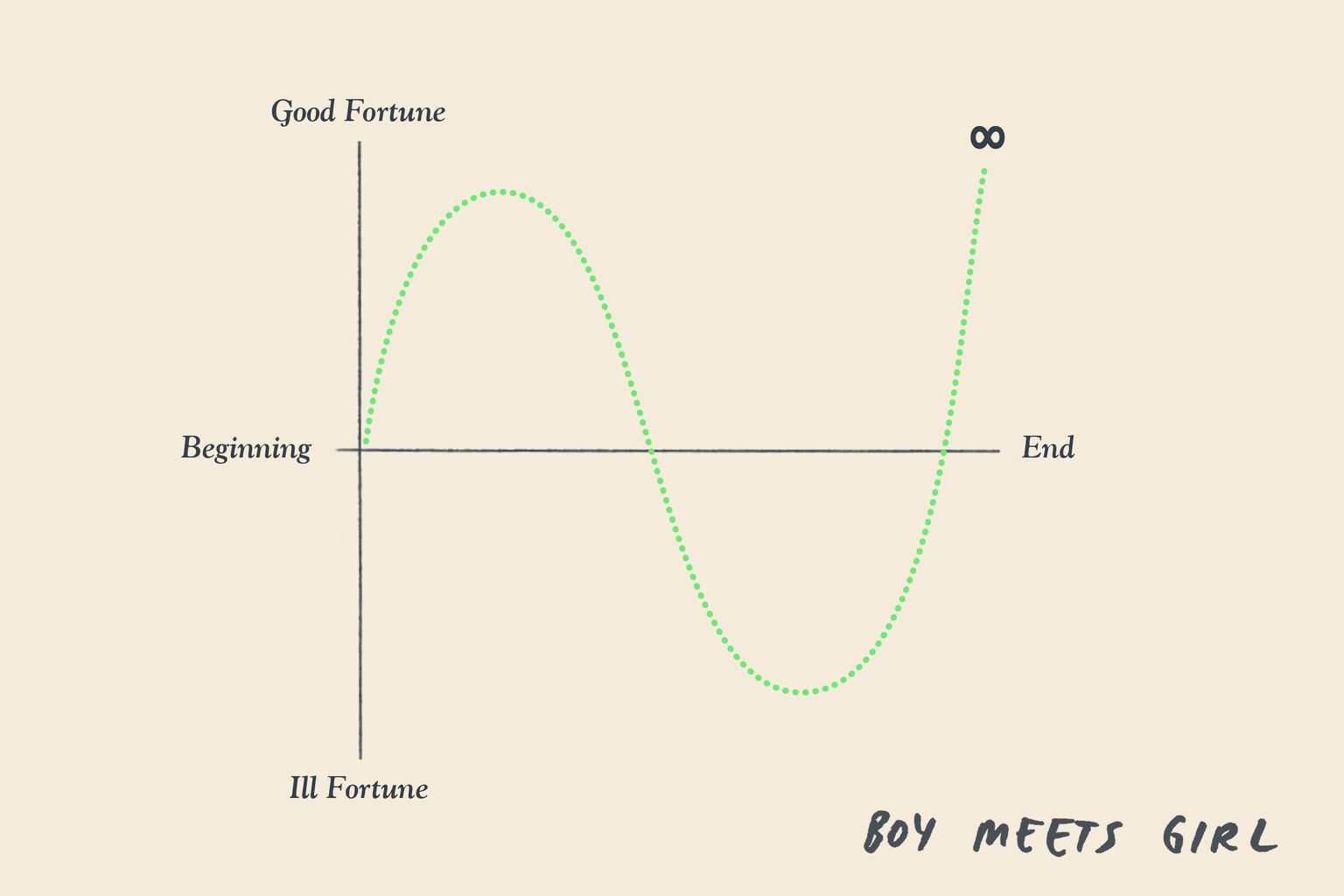
Vonnegut came up with eight shapes in total, and claimed that every story ever told—from the oldest fairy tales to Shakespeare right up to works of 20th-century modernism—corresponded to one of his charts. His most interesting observation: early Christianity and Cinderella follow the same plot points, the stroke of midnight mirroring our ejection from the Garden of Eden, and Cinderella’s rise to bliss with the prince reflecting our redemption through JC.
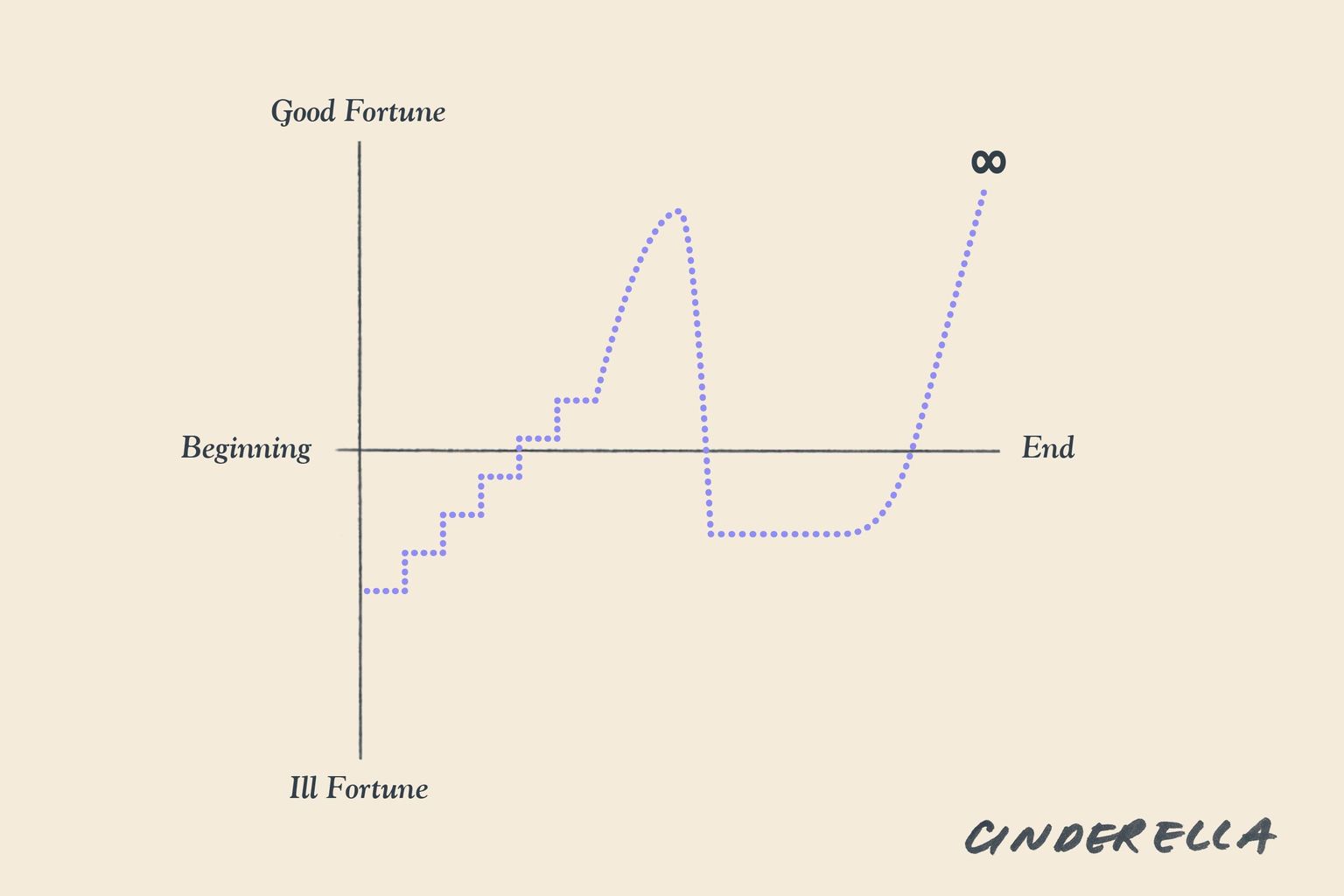
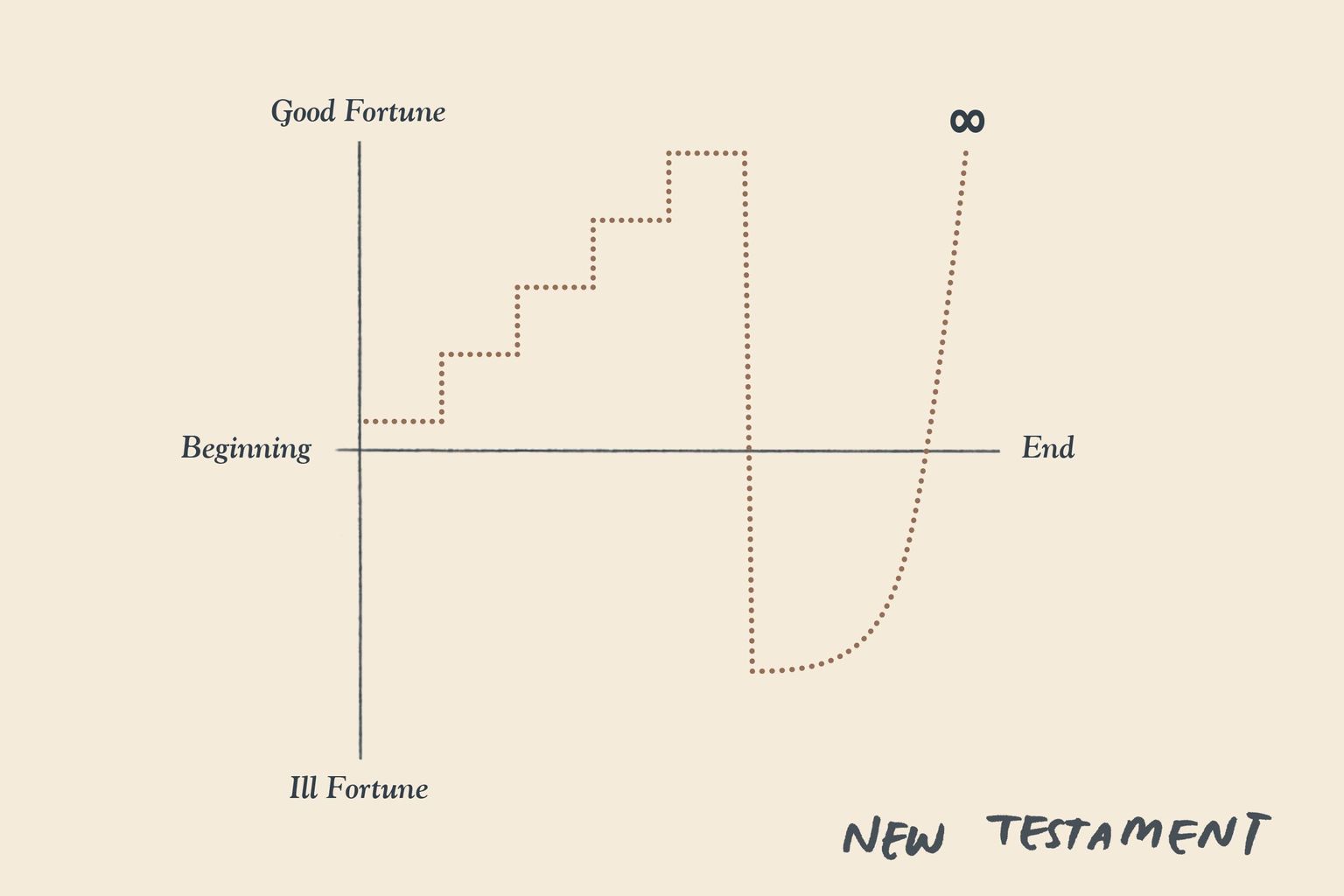
Of course, not every story ends happily ever after. Take Kafka’s Metamorphosis (or a random episode of Black Mirror). In these stories, things start off badly (maybe you’re depressed and overworked and no one likes you) and then proceed to get infinitely worse (you turn into a cockroach):

Vonnegut claimed that each of these diagrams (plus ones covering the Old Testament and early creation myths) represented the full spectrum of stories told within his culture.† He also claimed that examining these shapes might tell us something interesting about how his culture viewed reality and humanity’s place within it. But, he wondered, what about the story shapes of other cultures? Would they follow the same trajectories? Or would they be altogether different, reflecting different ways of seeing and being in the world?
The answer, of course, is that we don’t know—Vonnegut’s anthropology professors saw to that when they rejected his thesis proposal. But one question we might be able to answer is whether the university was right to reject him. Did they really turn their noses up at the idea because it was “too much fun”? Or was Vonnegut not the budding anthropologist he made himself out to be?
To find out, we went straight to the source (well, as close as we could get). Richard Shweder is a professor of anthropology at the Univesity of Chicago, the very institution that spurned Vonnegut back in the 1940s. And as it happens, he’s more than happy to talk about stories and shapes and what it all does or doesn’t mean. Over a video call, I step Professor Shweder through Vonnegut’s theory and ask him what he thinks of the author’s anthropological chops.
“It is a fine, fascinating—and even fun—topic,” Shweder says, before pointing out that Vonnegut wasn’t the first to come up with the idea of charting stories on paper. This is true enough: as far back as 335 BCE, Aristotle was breaking Homer’s Odyssey into its rudimentary parts to reveal a common shape at the heart of his people’s epics and tragedies. That idea—that humans tend to gravitate toward certain story arcs—would reach a kind of zenith in the 20th century with the advent of structuralism, the theory that human thought processes are more or less the same across all times and cultures.
Enter Vonnegut. By the time he started at U. Chicago, structuralism was an up-and-coming school of anthropological thought. The movement’s founder, Claude Lévi-Strauss, spent his time looking for patterns and similarities across ancient myths, and claimed that humanity’s stories were, in the aggregate, basically identical. (Joseph Campbell would touch on a similar theory around the same time in The Hero With a Thousand Faces.)
Ask Vonnegut what story shape best summed up our experience of reality, and he’d tell you straight: Hamlet.
Today, entire fields of anthropology are dedicated to disproving structuralism, favouring more nuanced understandings of how cultures tell their stories and what we can learn from the differences. But Shweder says that when Vonnegut was loitering around the university, the idea of examining a culture’s stories for similarities or differences hadn’t yet taken hold. He may have simply been ahead of the curve, Shweder says, meaning the department simply didn’t know what to make of his theory.
As an anthropologist specialising in cultural psychology, Shweder more or less takes the opposite position to Lévi-Strauss: our minds, he says, and the stories those minds tell, are all different. So, does Shweder think that Vonnegut’s graphs may have contributed anything useful to that analysis? Could they have backed up his idea about cultural difference, and maybe taken Lévi-Strauss down a notch? Shweder isn’t entirely sure.
His reservation has less to do with Vonnegut’s theory than his methodology: when you simplify a story as much as Vonnegut does, reducing our expulsion from the Garden of Eden to a datum on a line graph, you can’t really say all that much about it. “If you're only looking for the lowest common denominator, then you might well find that a story, a pot and a weapon have the same shape,” he says. “You wouldn't be able to tell the difference at that level of analysis. Are you looking at a piece of ceramics in a museum? Are you looking at a spear? Are you looking at Cinderella?”
Part of the problem, Shweder says, stems from the simplicity of Vonnegut’s charts. Yes, all stories have plot points, and their characters experience differences in good and bad fortune that can be measured over time. But the best stories—the ones that stand the test of time—embroider those elements with nuance. When a story resonates with a culture, how much of that resonance can we attribute to what’s happening on Vonnegut’s Y axis, and how much to the details added over them?
It might sound like another thesis question in the works. But budding students should approach with caution. For Shweder, Ludwig Wittgenstein put it best when he wrote, “In order to find the real artichoke, we divested it of its leaves.” “That's what structural analysis feels like to a lot of people,” Shweder says. “By the time you get there, nothing's left but the bare bones. You're not telling the story anymore.”
Shweder may not be about to award Vonnegut a posthumous degree. But it turns out he doesn’t have to. About a decade after Vonnegut published Cat’s Cradle, the University of Chicago accepted the book in lieu of a thesis and awarded Vonnegut a master’s in anthropology. As Vonnegut said shortly after, “This was not an honorary degree but an earned one, given on the basis of what the faculty committee called the anthropological value of my novels.” Vindication, at long last.
Which, if you’ve read much Vonnegut, shouldn’t come as a huge surprise: the man knew what it meant to be human (even if he expressed that knowledge through stories about time travel and space hounds). Ask Vonnegut what story shape best summed up our experience of reality, and he’d tell you straight: Hamlet.
Shakespeare’s play doesn’t follow a clear arc, and for a time Vonnegut wondered if it would resist being graphed. Arbitrary things take place one after the other which our protagonist merely endures, and no one is sure whether they’re good or bad. Thus the straight line:
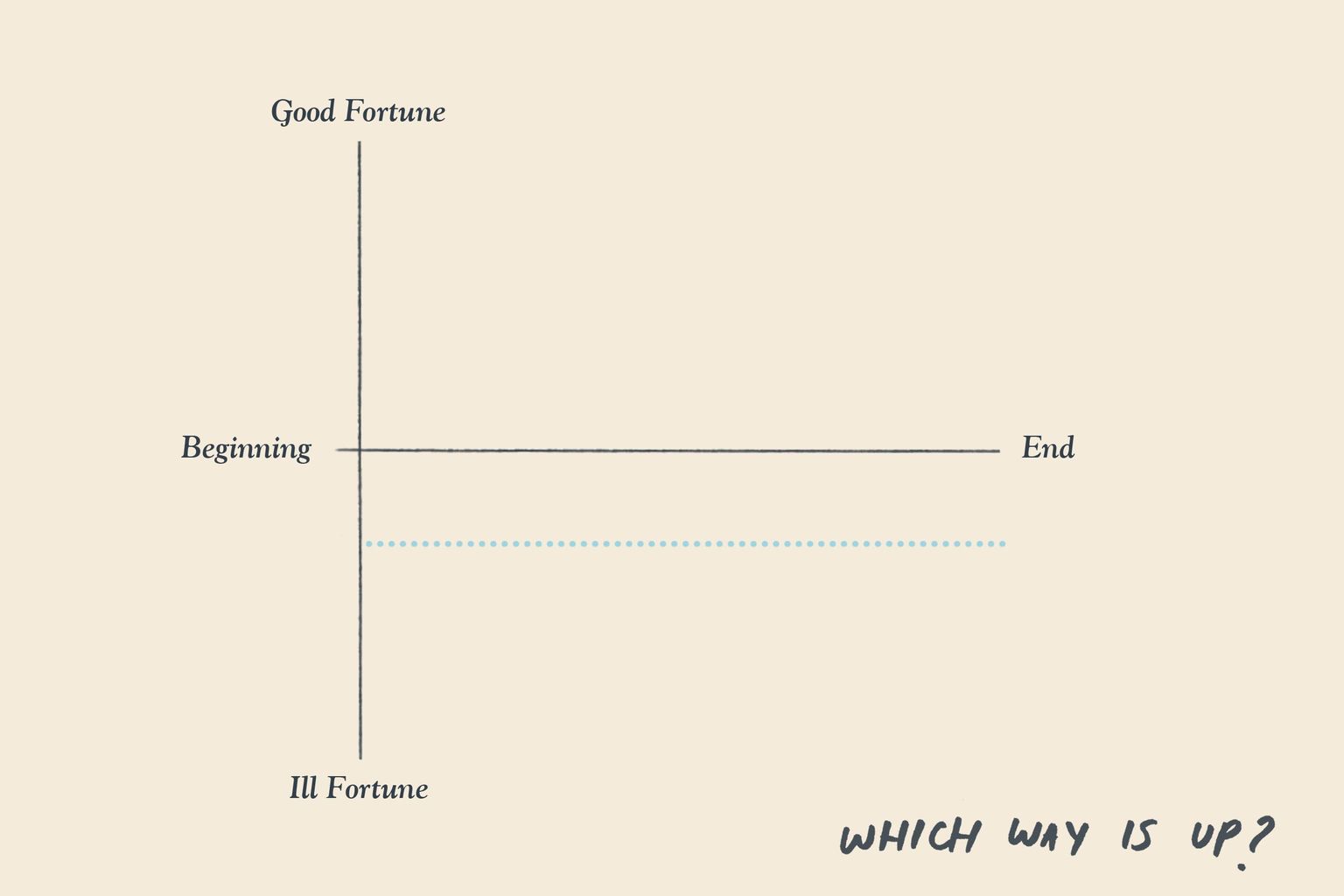
Though things happen in Hamlet, Vonnegut claimed it was impossible to assign them a positive or negative value; as mere mortals, we're ill-equipped to determine up from down on a cosmic scale.
This, Vonnegut says, is just like real life: from a universal perspective, a thing that happens to you is neither good nor bad, but rather “just something that happened”. Whether Hamlet is better or worse off for seeking revenge isn’t really for us or Shakespeare to say. “We’re so seldom told the truth”, Vonnegut said, “but Hamlet tells us we don’t know enough about life to know what the good news is and the bad news is.”
This is the shape of life as we really live it: arbitrary, convoluted, lacking even the semblance of a happy-ever-after (or its Kafka-esque opposite). Faced with that chaos, it makes sense that humans have spent much of their time on this planet crafting stories that follow neater trajectories, bringing order to the world instead of revelling in its meaninglessness. And it makes sense that one of those humans decided to draw a few graphs that sought to explain those stories, teasing just a little more signal from the noise in the process.
† Though as with all things Vonnegut, it’s possible he never really intended his theory of story shapes to be taken seriously, and instead proposed the whole thing as a playful thought experiment. Vonnegut often pushed things to an absurd extreme to make people think about something fundamentally true, even if he didn’t really mean what he was saying. Confusing.
